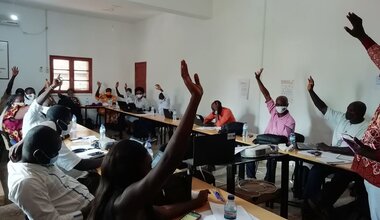Malaria: If prevention measures continue, the prevalence rate can drop further- Official
According to experts, malaria is an endemic disease of stable transmission and high prevalence, cause of many deaths.
According to Paulo Djata, "a lot of progress has been made in the fight against malaria from 2000 to 2015, not only in decreasing the number of cases, but also the number of deaths.
According to data from the National Program to Fight Malaria, in 2016 the number of serious cases was 16,387, simple cases with Rapid Diagnostic Tests (TDR), 97,367, positive species drop, 52,973 and number of deaths were 191. The total number of cases in the last year at the national level was 114,000, said Paulo Djata.
The World Health Organization (WHO) has been supporting the country in the definition of policies and strategies, as well as in the development of malaria control documents. WHO malaria counselor Fernanda Alves said WHO intervened through the ministry of Health and partners in disease prevention, especially among pregnant women and children under five years of age.
"Malaria is an endemic disease that exists throughout the country and can be transmitted across the whole Guinea-Bissau, but mainly affects children under five and pregnant women, so WHO has outlined a series of preventive interventions for the whole population and also for the two groups mentioned above: promotion and use of long-lasting impregnated nets and another one aimed at pregnant women, which is an intermittent preventive treatment and finally the chemo-prevention of seasonal malaria," explained Fernanda Alves.
For his part, Global Fund project manager George Ionita said that his organization is working with UNDP in partnership with the government to combat malaria in three areas: prevention, treatment, care and support.
Ionita warned that "Gabu and Bafatá are the two regions with the highest prevalence of malaria, essentially the region of Gabu that has an average five times higher than the national average, at 5 percent, which means that one in every 20 people is infected with malaria and in Bafata, the average is 2 percent, that is, two in a hundred people are infected."
For the Regional Director of Health of Gabú, Antonio Pedro Sidjanho, "Malaria is the major cause of death in the population, especially in children under 5 years of age, resulting from the late arrival of patients in the health centers in the region associated with beliefs in traditional alternative treatments that the population uses at first place."
Despite being an ambitious target, the World Health Organization says it is possible to eliminate malaria by 2030. This guarantee was given on 25 April last year, on World Malaria Day. In 2015, the World Health Assembly approved a strategy calling for the elimination of malaria in at least 10 countries by the year 2020.
Across sub-Saharan Africa, where the disease is heavily concentrated, a larger proportion of the population has been using insecticide-treated nets. By 2015, about 53 percent of the at-risk population slept under a treated net compared with 30 percent in 2010. In 20 African countries, preventive treatment for pregnant women increased fivefold between 2010 and 2015.
 UN
UN





